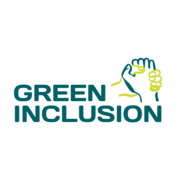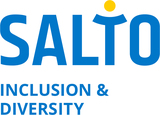Report Green Inclusion
The full report - The introduction - Chapter 1 - Chapter 2 - Chapter 3 - Chapter 4 - Chapter 5 - Chapter 6 - Chapter 7
About the seminar Green & Inclusion
Environment and climate action were added as a horizontal priority within the Erasmus+ Programme. By this, the Programme is considered a key instrument for building knowledge, skills, and attitudes on climate change and supporting sustainable development within the European Union and beyond. While this focus is crucial, it also draws attention to the challenges that young people with fewer opportunities (YPWFO) are facing. For example, young people with fewer opportunities are the first to feel the consequences of climate change, while they are often the last to be heard. Also, mainstream solutions to fight climate change are more easily available for well-off people, while young people with fewer opportunities often lack resources to use them. In the context of the Erasmus+ Programme, measures to make projects greener might raise barriers or even exclude YPWFO to participate. In short, there’s a clear need to connect the fields of green and inclusion.
As a first exploration of this intersection, SALTO Inclusion & Diversity, the Netherlands Youth Intitute, BIj and Jugend für Europa organised the Seminar Green Inclusion. The seminar aimed to start discussions to understand more: what does Green Inclusion mean? What is this new field we are trying to envision? We looked for a better understanding of the struggles of young people with fewer opportunities and the barriers they experience to participate in Green projects, and also how to bring Green emphasis to projects with more vulnerable young people.
We hoped to discuss the different realities from these two sides; find some preliminary solutions (or a base for solutions) for organisations and projects; and find common ground between the two European horizontal priorities.
About the report
This report is a collection of inputs gathered during the Green Inclusion seminar. The seminar had 36 participants from 11 countries and ran over 3 days, 16-18 November 2022. An internal report is available here, which gives detail of what happened, and how the outputs were created. The external report aims to spread the discussions, recommendations and outputs to a wider audience, to continue growing the interest and action for green inclusion in European Programmes.
The report is structured in 8 sections. Each one focuses on a particular aspect, and it is hoped that the contents of each section could also be used in a standalone fashion, if needed. We are looking for the content of some of these sections to be built on, expanded; used for further activity, strategy, development.
With this report, we want to promote the development of more research on the subject; the creation of different trainings; the expansion of new networks; the deployment of political advocacy and lobbying for political change; and finally, more projects and activities for more young people. That hope is why we spent
time gathering the information and putting it here for you to read.

Seminar Green Inclusion.
Downloads
The following downloads are available:
- Green Inclusion Report
A collection of inputs gathered during the Green Inclusion seminar, hosted in Amersfoort, Netherlands, 15-18 November 2022
- Green Inclusion Report - Introduction
Introduction to the Green Inclusion External Report
- Green Inclusion Report - Chapter 1
What makes it hard to do more quality projects with positive impact under this priority? What is blocking that progress, getting in the way of better delivery?
- Green Inclusion Report - Chapter 2
What are the positives, competences and existing benefits that the NGO field already has, in its work with the youth and community related to green inclusion?
- Green Inclusion Report - Chapter 3
How to improve green inclusion in the youth field?
- Green Inclusion Report - Chapter 4
Moving to a definition of Green Inclusion.
- Green Inclusion Report - Chapter 5
Tips for projects and organisations.
- Green Inclusion Report - Chapter 6
Recommendations on Green Inclusion on the wider level.
- Green Inclusion Report - Chapter 7
Hungry for more? Check these resources.
